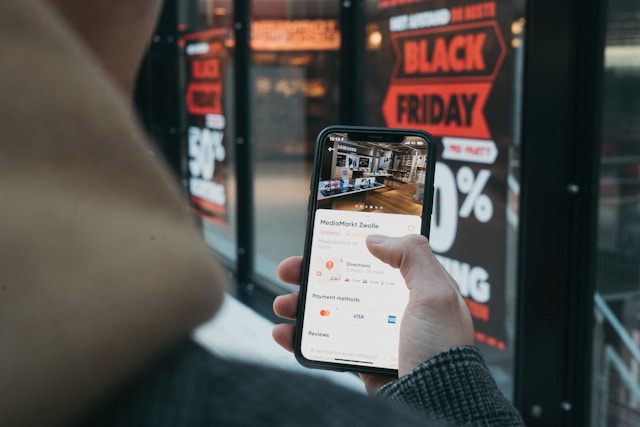You’ve probably been receiving emails, app notifications, and mail for days (maybe even weeks) about all the ways you can save this Black Friday. Even if you’ve avoided personalized marketing, signs, advertisements and billboards exist. Avoiding overspending amid all this noise is challenging, but possible. Here’s how.
1. Check the price history
Are you actually getting a good deal? A lot of retailers raise prices weeks or months before Black Friday, allowing them to ostensibly offer deep discounts. In reality, they sell those items at the usual price or offer paltry discounts, meaning you are tricked into taking advantage of what you think is a good deal, causing you to spend too much money.
Raising prices to make discounts look better is technically illegal. However, many retailers still do it because it is difficult to prove: you would have to track the price of a product for months, if not years. The great thing is that there are many free price history tools out there. If you’re shopping online this holiday season, use one to see if you’re actually getting a good deal.
2. Plan purchases in advance
Have you been looking for solar panels for a while, but can’t find a good deal? Do you urgently need an energy-efficient heater this winter? If you plan your purchases, you are less likely to overspend. Be sure to categorize items into separate “needs” and “wants” lists. This way you can prioritize the first list.
3. Consider future costs
Some items you can buy on sale will ultimately save you money. For example LED lamps lasts 25 times longer than conventional light bulbs, while consuming 75% less energy. Considering long-term costs puts deals into perspective (especially if you’re planning on making a large purchase) and prevents you from overspending on flimsy or resource-intensive items.
Consider your purchases as investments. You can calculate return on investment (ROI) by subtracting the cost of the item from the revenue and then dividing that number by the price of the item. Let’s say you spend $950 on a solar panel, saving you $1,500 in electricity costs that year, leaving you with $550. Add that figure to the formula and you get a 57% ROI in the first year.
4. Pay in cash or with PIN
It’s easy to overspend with a credit card. According to one study approximately 37% of credit card holders reached their credit limit – or came close to it – from March 2022 to October 2024. On Black Friday, you may be tempted to put more things on credit than you normally do, rationalizing away your worries in the knowledge that you’re getting great deals . Pay in cash or with a debit card so that you are not burdened with high payments. Your future self will thank you.
5. Check the fine print again
Have you ever thought you were getting a good deal, only to find out at checkout that it didn’t apply? Whether the discount was only offered online, the store limited the amount you could buy, or your item was excluded from the sale, the feeling can be frustrating. Many retailers are counting on you to overlook the fine print. This year, don’t give them the satisfaction: check whether you have to spend a certain amount, have a store card or show up at a certain time.
6. Remember other opportunities
Do you remember Small Business Saturday? It’s quite a big deal. People collectively spent $17 billion compared to the country’s more than 34 million independent businesses by 2023. They may not have as much variety as big box stores, but supporting local businesses is a great way to source products sustainably.
What about Cyber Monday? Online stores offer big discounts on thousands – sometimes millions – of items. If you’re tempted to buy something but the deal isn’t satisfying, wait a few days. Remember that there is almost always an opportunity to get the goods you want at a price you think is fair.
7. Set a budget and stick to it
Spending too much usually means buying more than you can afford. The average person spent about $390 on Black Friday in 2022. Is that within your budget? If you haven’t already done so, determine the maximum amount you are willing to part with. Once you set it, stick to it. For more control, you can create a breakdown of how much you want to spend on each item you want to purchase.
8. Consider the lifespan of the product
Spending too much doesn’t necessarily mean spending more; it can also mean spending more than necessary. Would you rather buy a sustainable organic cotton shirt with a 40% discount or a thin, cheaply made polyester shirt with a 98% discount? Even though the latter seems like a better deal, it won’t hold up as well over time.
Avoid spending too much money on Black Friday by purchasing items that will save you money in the long run. Check each product’s warranties, ratings, and materials to see if they will hold up over time. This approach is not only environmentally conscious, but also ensures that you get the most out of your purchases.
Keep these tips in mind while shopping on Black Friday
The temptation to take advantage of high discounts is great, but you are stronger. Prepare accordingly and remember these tips when shopping to avoid overspending on Black Friday. If you can’t get all your shopping done, you can absolutely reuse these tips for Small Business Saturday and Cyber Monday.
Author biography
Jane is an environmental writer and founder and editor-in-chief of Milieu.co where she covers sustainability and eco-friendly living.





